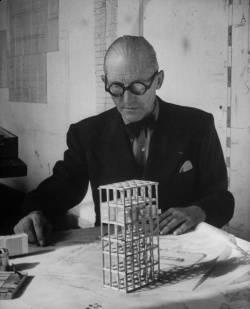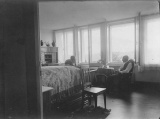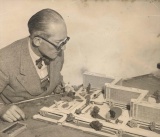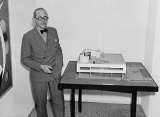Difference between revisions of "Le Corbusier"
Sorindanut (talk | contribs) |
Sorindanut (talk | contribs) |
||
| Line 68: | Line 68: | ||
* ''Étude sur le mouvement d’art décoratif en Allemagne'' (''Study of the decorative art movement in Germany''), 1912. (in French) | * ''Étude sur le mouvement d’art décoratif en Allemagne'' (''Study of the decorative art movement in Germany''), 1912. (in French) | ||
* ''Vers une architecture'', 1923. (in French) | * ''Vers une architecture'', 1923. (in French) | ||
| + | * ''L'Urbanisme'', 1924. | ||
** [[Media:LeCorbusier_Towards_a_New_Architecture_1986.pdf|''Towards a New Architecture'']], 1931; 1986. | ** [[Media:LeCorbusier_Towards_a_New_Architecture_1986.pdf|''Towards a New Architecture'']], 1931; 1986. | ||
* ''El viaje de Oriente'', 1984; 1993. (in Spanish) [http://visible-art.com/userfiles/file/Architectural%20Magazines/Le.Corbusier-El.Viaje.A.Oriente.pdf] | * ''El viaje de Oriente'', 1984; 1993. (in Spanish) [http://visible-art.com/userfiles/file/Architectural%20Magazines/Le.Corbusier-El.Viaje.A.Oriente.pdf] | ||
Revision as of 09:57, 16 December 2013
Charles-Édouard Jeanneret-Gris, better known as Le Corbusier (1887 – 1965), was an architect, designer, painter, urban planner, writer and one of the pioneers of what is now called modern architecture. His career spanned five decades, with his buildings constructed throughout Europe, India, and America.
Life and work
He was born in Switzerland and became a French citizen in 1930. Young Jeanneret was attracted to the visual arts and studied watch engraving at the La-Chaux-de-Fonds Art School, under Charles L’Eplattenier (1900). In 1904, he entered the Advanced Decorative Arts Course (based at the Art School) directed by Charles L’Eplattenier, who acquaintes Le Corbusier with architecture.
A member of the Board of the Art School, Louis Fallet commissioned the young architect to design a villa (Villa Fallet) in La Chaux-de-Fonds, which he built in collaboration with the architect René Chapallaz. It was his first commission as an architect at the age of 17. It was completed in 1905. Now it is recognised as a building of cultural significance in Switzerland.
In September 1907, Le Corbusier took a trip to Italy for two and a half month (Milan, Florence etc.), and on his way back in Vienna he worked on the plans for the Stolzer and Jacquemet villas (La Chaux-de-Fonds). In Paris, he worked for Auguste and Gustave Perret as draughtsman, half-time (1908). In autumn 1909 he returned to La Chaux-de-Fonds to supervise construction of the Stotzer and Jacquemet villas.
In May 1911, he left Dresden for a journey to the East: Prague, Vienna, Budapest, Belgrade, Bucharest, Tarnovo, Gabrovo, Kasanlik, Istanbul, le Mount Athos (21 days), Athens and southern Italy, in the company of his friend Auguste Klipstein, an art history student. During this trip, he made numerous drawings, sketches and notes in his sketchbooks, as well as several hundred photographs.
In 1912, he built for his parents the villa Jeanneret-Perret in the rue de la Montagne and the Villa Favre-Jacot in the town of Le Locle.
Next year he had an exhibition of 10 watercolors Le langage des Pierres [The Language of Stones], at the Salon d’Automne, Paris and received the certificate of competency for teaching art.
In 1914, he travels to Cologne for the Deutscher Werkbund exhibition and conference and begins studies on his Dom-ino concrete house project. The name (domino) is from the floor plan resembled a domino game piece and because the units could be aligned in a series like dominoes, to make row houses of different pattern.
In 1915, he works on his manuscript La construction des villes. He builds Villa Schwob and the Scala cinema in La Chaux-de-Fonds (1916).
In 1917 he leaves his native town (La Chaux-de-Fonds) and opens his first Parisian architecture studio at 20 rue de Belzunce (10th arrondissement), then at 29 rue d’Astorg (8th arrondissement). He lives in Paris at 20 rue Jacob (6th arrondissement) until 1933. He works as consultant to the SABA (Société d’application du béton armé) from April 1917 to January 1919.
In 1918 Le Corbusier paints La cheminée and have the Purist exhibition at the Galerie Thomas in Paris, with the painter Amédée Ozenfant.
In 1919 he launches L’Esprit Nouveau magazine with Amédée Ozenfant and Paul Dermée.
1920 is important in his biography because he adopts the pseudonym "Le Corbusier" for his architectural persona, derived from his maternal grandfather, Lecorbésier. Adopting a single name to identify oneself was in vogue by artists in many fields during that era, especially in Paris.
In 1921 he exhibits paintings ("des peintures puristes") with Amédée Ozenfant in the Galerie Druet (Paris). On the graphic poster appears in block capital the name "Jeanneret".
In 1923 he publishes Vers une Architecture (based on articles published in "L’Esprit Nouveau"), published in English in 1927 as Towards a New Architecture. One year later he establishes his architectural office at 35 rue de Sèvres (6th arrondissement) and gives lectures in Geneva, Lausanne and Prague. Same year he publishes L’Urbanisme (based on articles in L’Esprit Nouveau magazine).
Works
- Selection
- Villa Fallet, Switzerland, 1905
- Villa Stotzer, Switzerland, 1907
- Villa La Roche, Paris, France, 1923
- Villas at Weissenhof Estate, Stuttgart, Germany, 1927
- Tsentrosoyuz, Moscow, Russia, 1928
- Maison Errazuriz, Chile, 1930
- Curutchet House, La Plata, Argentina, 1949
- United Nations headquarters, New York City, 1952
- Mill Owners' Association Building, Ahmedabad, India, 1951
- National Museum of Western Art, Tokyo, Japan, 1957
- Philips Pavilion at the World Expositon Brussels, Belgium, 1958
- Center for Electronic Calculus, Olivetti, Milan, Italy, 1961
- Church of Saint-Pierre, Firminy, Firminy, France, designed in 1960, built posthumously and completed under José Oubrerie's guidance, 2006
Literature
- By Le Corbusier
- Étude sur le mouvement d’art décoratif en Allemagne (Study of the decorative art movement in Germany), 1912. (in French)
- Vers une architecture, 1923. (in French)
- L'Urbanisme, 1924.
- Towards a New Architecture, 1931; 1986.
- El viaje de Oriente, 1984; 1993. (in Spanish) [1]
- Analisis de la Forma, 1984. (in Spanish) [2]
- Willy Boesiger, Oscar Stonorov, Max Bill (eds.), Le Corbusier - Oeuvre complete, vol. 1 (1910-1929), Vol. 2 (1929-1934), Vol. 3 (1934-1938), Vol. 4 (1938-1946), Vol. 5 (1946-1952), Vol. 6 (1952-1957), Vol. 7 (1957-1965), Vol. 8 (1965-1969) (French, English and German Edition), 1990-.
- About Le Corbusier
- Jacques Lucan, Le Corbusier - Une Encyclopedie, 1987 (in French)
- Curtis, William J.R., Le Corbusier: Ideas and Forms, Phaidon, 1994
- Frampton, Kenneth, Le Corbusier, London, Thames and Hudson, 2001
- Eliel, Carol S., L'Esprit Nouveau: Purism in Paris, 1918 - 1925. New York: Harry N. Abrams, 2002
- Flora Samuel, Le Corbusier in Detail, 2007




